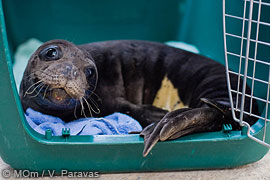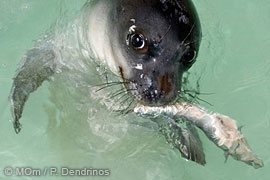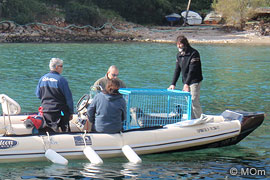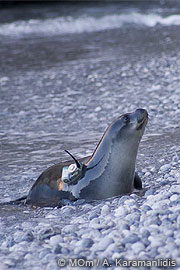

 |
||
 |
||
Vol. 13 (1): June 2010 |
||
Nefeli’s Rehabilitation: Methods, Results, and ChallengesEmily JosephMOm/Hellenic Society for the Study and Protection of the Monk Seal
|
 |
|
|
|
Nefeli, the most recent orphan in MOm’s Monk Seal Rehabilitation Centre in Alonnisos, Northern Sporades, was discovered by locals in Assos, Kefalonia, on 14 October 2009. The pup – weak, dehydrated, and having suffered superficial wounds mainly to her chin and flippers – had hauled up on a boat ramp while locals contacted MOm. Following established procedures, MOm’s rescue team advised volunteers via telephone, asking them to maintain a watch for the possible return of the mother and, once hours had passed with no sign, the volunteers were asked to move the pup (whom they dubbed “Nefeli”) to a safe location.
The rescue team was immediately dispatched to the island where they began a primary assessment of the animal and, in collaboration with the Veterinary School of Thessaloniki, began administering first aid. The pup was estimated to be 10 days old based on weight (15kg), standard length (100cm), the presence of 2 emerging canine teeth on the lower jaw, absence of the umbilical stump, and an intact lanugo (moulting had not yet begun). As the determination was made to transport the animal to MOm’s rehabilitation centre for treatment, the pup, under the veterinary supervision of Dr. Natassa Komninou, was started on a broad-spectrum antibiotic as a precaution for any infection and to prepare the gut for the rigors of an early transition to a fish-based diet. A blood sample was also taken, revealing that the seal was in relatively good condition, though exhausted and underweight.
Upon arrival at the rehabilitation centre in Alonnisos, the animal was again examined by the rehabilitation team. Lethargic after a long journey, only electrolyte fluids were administered for the first feedings, tuna-based “soup” being introduced slowly on the second day. An anthelmintic was also prescribed until a fecal sample could be collected to confirm an absence of parasites.
Nefeli was slow to stabilize, and it was not until her third week in rehabilitation that she began to steadily gain weight. She did, however, become increasingly active as the days passed, and was especially energetic during her first swims, vocalizing almost incessantly and holding nearly half of her body out of the water as she swam in rapid circles.
 |
|
|
|
After a few weeks in the centre, Nefeli began to show many positive signs for survival. The pup adjusted easily to her new tuna soup diet and the addition of salmon oil to her meals assisted in steady growth and regular bowel movements. By the end of her third week in rehab, all of her wounds had closed, and the seal began moulting.
Live fish were introduced to the pool on the fourth week, and Nefeli showed an incredible aptitude for hunting: she would remain submerged for minutes at a time, chasing and killing fish by her third encounter.
By her sixth week in the centre, the pup’s diet began to include tuna fillets, while her intake of tuna soup was slowly decreased and finally stopped. It was around this time that Nefeli began to display her “wild side”, indicating her preferences for individuals, handling, and feeding (and simultaneously demonstrating the effectiveness of her ever-incoming teeth). By week eleven of her stay, the seal ate from the edge of her platform, opening her mouth while staff members fed tuna fillets and, eventually, other fish species such as Scomber scrombus and Trachurus trachurus.
As with other rehabilitation patients, it is at this point that seals are encouraged to begin feeding in the pool; and Nefeli started out as the others, accepting hand-fed fish in her pool. It was not long, however, before she discovered that her handlers’ degree of control over a swimming seal was minimal. She began staging “swim-bys” where she would take fish in her mouth and then deposit them just out of staff reach; “grab and rolls” whereby she would wait until the staff attempted to push the fish into her mouth, secure both fish and hand in her teeth, and commence a log-roll; or the “cold shoulder” in which she would swim placidly around her pool, taking no notice of offered food. Though she continued to kill and play with the live fish, any consumption on her own accord remained minimal. If offered food from her preferred place at the edge of platform, however, Nefeli was generally easy to feed.
As the weeks passed, the seal began to approach the 50 kilo goal-weight for release. Though the winter seas make such planning difficult, a date was set for 30 January. Beginning with Nefeli, each released seal will be flipper tagged (Nefeli is sporting light blue tags #003 and 004 on her hind flippers) and micro-chipped to ensure identification well into the future. In addition, the seal was outfitted with a satellite GPS transmitter to allow MOm staff to monitor her adjustment to the wild.
 |
|
|
|
In the middle of 2010’s horrendous winter, January 30th proved to be a beautiful, calm day. With the help of the Hellenic Port Police, a 54-kilo Nefeli was escorted to the heart of the National Marine Park of the Northern Sporades, Piperi Island. As soon as her transport cage was opened, Nefeli immediately headed for the beach and, it seems, immediately forgot about her time in captivity. She checked out her new surroundings, smelling the rocky beach, looking up at the cliffs around her, tasting a pile of seaweed, and finally heading into the surf.
Nefeli’s stay was the shortest yet recorded in MOm’s Monk Seal Rehabilitation Centre: in 16 weeks, the young pup transformed from a baby into a sleek and wild juvenile. Part of her success was the fact that, beyond her initial malnutrition, the pup had no medical issues holding back progress. Another major contribution is the addition of salmon oil to the monk seal diet which helps to add vital extra calories and facilitates a steady weight gain. The contribution of MOm’s established and proven protocol, based on 20+ years of experience and research is yet another factor that cannot be overlooked, along with the expertise and guidance of the University of Thessaloniki’s Veterinary School and particularly Dr. Natassa Komninou. In addition, the dedication of MOm’s many volunteers who lend vital support to the programme and the financial support of Piraeus Bank and private donors must be mentioned with greatest gratitude.
 |
|
|
|
Weeks later, the satellite tracking has proven that Nefeli was quick to adjust to her new life. She has travelled far and wide within the marine park, making journeys out to the neighbouring islands of Kyra Panagia and Gioura before returning exactly to her release beach, circumnavigating the island of Piperi, and finally heading out as far as Pelion and Skiathos.
She has also made repeated dives to depths of up to 120 metres in her first month and a half in the wild. The last transmission from the satellite monitor was received on 17 March 2010. While the reason for the subsequent lack of data is unknown, the most likely causes are either technical, or that the transmitter detached from the seal. Though it was hoped that the tracker would provide information for a longer duration, such technical difficulties remain a frustrating obstacle to the collection of much-desired data on the behaviour and habits of the Monachus monachus species. The 1.5 months’ worth of signal that were received, however, provided ample data to indicate Nefeli’s successful rehabilitation and reintroduction into the wild.
Here’s hoping that the future will remain bright for MOm’s latest graduate and that sightings of a blue-tagged seal will lighten our hearts for years to come.
Copyright © 2010 Emily Joseph, The Monachus Guardian. All Rights Reserved |